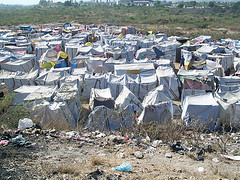What if We Could Rebuild Haiti?
By: Amos S. Eno
Posted on:12/20/2011 Updated:03/23/2012The serendipitous story of how Wood for Haiti was created
This is a continuation of the story of Wood for Haiti, replete with serendipitous coincidences. If you don’t believe in coincidence, perhaps it is the story of much greater hidden forces at work . . .
By September 2010, after his epiphany concerning the harvest of beetle-killed wood, Gary managed to meet with Chelsea Thomas, a staffer for Sen. Max Baucus who handled trade issues. Gary asked her, “What if we could solve three problems at once?” The program would 1) provide relief for the homeless in Haiti (at that time 1.2 million people) using some of the $9.9 billion in pledges to the World Bank which had come from about 60 countries; 2) encourage the Forest Service to begin restoration of some 7 million acres of national forest in Idaho and Montana by removing beetle-killed trees and reforesting; and 3) help beat back the economic recession by creating timber and mill jobs. 
An Idea That Happened
“We could ship the wood and take building advisory teams to Haiti,” Gary concluded. “Chelsea told me, this is really interesting and she asked me to write it up. After a month she called to say we love your idea. After a conference call to discuss the idea, they were more excited than I was . . . and this was just an idea that happened!”
As we know, things move slowly within the corridors of power, so a year later, in January 2011, Gary, once again, found himself back in the Minneapolis airport. He received a call from Baucus’s DC office and was told to get a request from Haiti for the wood. “How do I do that?” he asked. “You’ll just have to figure that out!” he was told.
As serendipity would have it, on his flight that day, Gary just happened to sit next to a woman named Colleen Mooney. Believe it or not, she was just returning from Haiti, and as founder of the Microcredit Bank of Haiti, she said, ‘I can put you in touch with the right people down there.”
Seriously, folks, this is a true story!
“I began to get really excited,” says Gary. “These coincidences that kept happening seemed to be a sign of something. Upon my return to Montana, our new neighbors dropped by for a visit. We talked about the Haiti project, and my neighbor got excited and said, ‘Let me make a few phone calls.’ Before long, I had a call from the UN!
“Basically it’s been a constant vetting process. Former President Clinton received a draft of the project in February 2011, and later his senior advisor told me that Clinton had seen the project and likes its immensity of scope. He encouraged me to continue working with his shelter policy people in Haiti.”
And so Gary has. Working with many other Montanans, he formed the nonprofit Wood for Haiti. Wood for Haiti has a very dedicated nine member Board of Directors and advisors that include a Montana wood products representative, forest policy experts, legal and business consultants, and field representatives from Congressional offices. Wood for Haiti emphasizes the relief effort in Haiti, while boosting employment in the U.S. and forest harvest/restoration are important secondary elements. However, Wood for Haiti has discovered the litigious nature of getting into the forest to log it.
The ecological effects of harvesting beetle-killed wood will be addressed in our next post this Thursday, Dec. 22.
The entire Wood for Haiti series:
Wood for HaitiHow beetle-killed wood from Western forests may be the key to rebuilding Haiti
What if We Could Rebuild Haiti?
The serendipitous story of how Wood for Haiti was created
Beetle-killed Forest: Why Harvesting May be the Best Option
How Wood for Haiti proposes to improve western forests while aiding Haiti
Wood for Haiti Embodies the Spirit of Christmas
Great Idea, Great Need, Great Story, Great Time to Give Beetle-killed Forest: Why Harvesting May be the Best Option. How Wood for Haiti proposes to improve western forests while aiding Haiti
 Sign In
Sign In
 Sign In
Sign In
